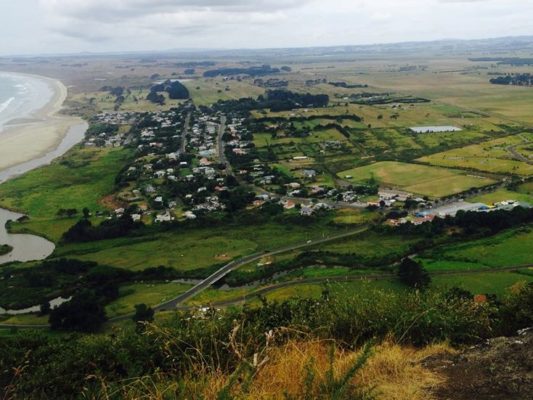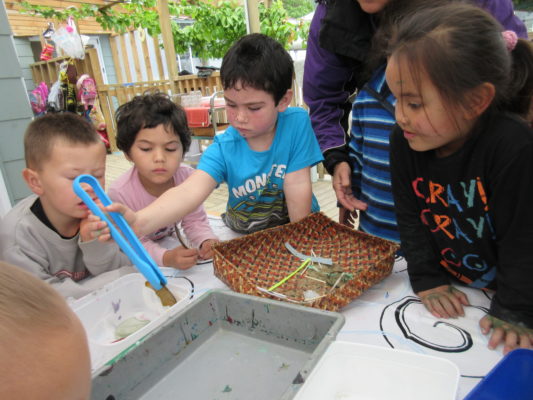They’re some of the youngest members of Ahipara’s small seaside community, but the children of Ahipara Sandhoppers are doing everything they can to help their environment from picking up rubbish, to growing plants for butterflies, trapping predators and even deconstructing broken appliances for recycling. What’s more – these Kaitiaki Kids haven’t even started school yet!

“We do beach clean ups, have a vegetable garden, have planted some fruit trees and source local fruit when available,” says Maureen Perry, Head Teacher of the Nga Puriri (3-5 year old group) of children at Ahipara Sandhoppers Early Childhood Centre. “We have a worm farm and children and teachers do lots of our repairs to our playground such as cleaning out our playground drains when needed.”
How many adults can say they’re doing as much? And that’s just the beginning! If you think you can match the Ahipara’s pre-schoolers, read on!
“Kaitiaki Kids is a programme that began life as a mere seedling,” explains Maureen. “The children began looking after our environment by collecting rubbish around the school, down at the beach, over at the rugby field. We had big tweezers to begin with – enabling the children to (secretly) develop their fine motor skills. We also now use tongs. This enables the children to collect the rubbish without the need to use gloves or get their hands dirty.”
As you would expect with such an environmentally conscious clean-up crew, plastic bags are definitely out these days!

“We began using plastic bags to collect it in,” Maureen admits, “but we now use re-purposed T.Shirt bags and we wash them after use. We then sort the rubbish and anything recyclable, reusable or rot-able is put into the appropriate box. We often discuss the harm that rubbish does to our environment and our ocean creatures. All the children soon become wildlife warriors.”
The children also take their eco-skills home with them at the end of the day and have been known to remind the adults in Ahipara about their environmental responsibilities.
“We have had a number of children telling adults out in the community to pick up their rubbish, when they see someone littering. Another child insists they pick up all the rubbish whenever they got to the beach, as our turtles might eat it,” says Maureen.
Ahipara is a small community of about 1000 people situated at the southern end of 90 Mile Beach.
“Ahipara Sandhoppers is situated on the Ahipara School grounds,” says Maureen. “We have 3 different areas – Nga Tipu for under 2s, Nga Puaawai for 2-3 and Nga Puriri 3-5yrs. Sandhoppers has been since 1993. Wairoa Stream is our awa (which runs along the back of our centre), Whangatauatia is our Maunga (which overlooks our centre), Ahipara is our beach (which is always there, waiting for us to visit – when we are able). Many of our Sandhopper whanau live in the area – so the beach and river is ‘our place’. “
The centre is licenced for 60 children, and have 80 different children on the roll, aged from 3 months to up to and including 5 years.
“Nga Puriri – my area – are involved with trapping,” says Maureen who is responsible for the 3-5 year olds, “However children from other areas sometimes come and help. We began trapping because we had a rat problem, getting into everything and it was something I did without child input. But when we had children who had an interest in this, it became something that Nga Puriri children took part in, if they wished.”
All parents were asked their permission to begin with.
“There was only one person who did not want their child to participate – but she was so interested that her mum changed her mind. Whenever we catch something the call goes out and almost all the children will come and look – sometimes almost not wanting to look, but do. They are all so excited and go and tell the rest of the centre about it. They also tell their parents about it.”

Children are also learning about why trapping is needed.
“It is also important for us to trap the predators as we have a very old puriri tree in our back yard that hosts kereru often. We want to protect these birds and all the other wildlife and sealife,” says Maureen. “DOC were generous enough to assist with some traps. This has meant that we have been able to have traps to set for possums, rats, mice and stoats.”
The children are very involved in checking the traps set up at the back of the centre and check them almost every day.
“To begin with we got quite few rats and mice and possums but this has now slowed down. We have a chart to document every predator caught, and this is checked often by the children to see how we are doing. Our only thing we have not caught is a stoat. But we are very keen on catching one.”
The children also know all the names of what the traps are for.
“We have a father who works for DOC and he has been providing lots of good advice,” says Maureen. “We have also had someone come and talk with our children about recycling and keeping everything that is not biodegradable out of our waterways and ocean. But mostly this is all done by the teachers.”
Predator control is a key part of a very full-on Kaitiakitanga programme at Sandhoppers.
“Our playground is filled with lots of plants and trees, we have plants for our monarch butterflies and bees. We do recycling – making trips to the recycle station in Ahipara to take loads of recycling items. We also have a recycling programme in our centre. Children are asked to think about what is recyclable and which bin it goes in. We use the 7 Rs – recycle, repurpose, rot, re-use, refuse, reduce and repair,” says Maureen.
And there’s more…
“We repurpose T.Shirts and singlets into re-useable bags and make net bags for vegetables,” says Maureen. “We repair our equipment whenever possible, rot any paper towels we use and anything we use that is bio-degradeable. All food scraps are sent for pig food, we use roller towels instead of paper towels and re-use anything we can for our collage area. Any appliances that are irreparable we use to develop our children’s deconstruction skills – then take it to the dump to recycle. We also refuse plastic bags wherever we can. Our kitchen staff take re-useable bags for shopping and we provide all the food for the children.”
Maureen has been working at Sandhoppers for over 20 years and has seen many changes since she has been there.
“We have started small and as the years roll on we have added more and more ways of being Kaitiakitanga of our back yard,” she says.
The programme that has evolved from that ongoing Kaitiakitanga development is an achievement that the teachers, children and parents of the Ahipara community can be well proud of.

